Skydiving is a thrilling sport that combines adrenaline, freedom, and breathtaking views. However, for Indians passionate about skydiving, there’s a significant hurdle: there are no certified skydiving schools in India.
But don’t let that stop you from chasing your dreams! With the right guidance and resources, you can travel to nearby countries to learn skydiving and earn your license.
About the Author of this article
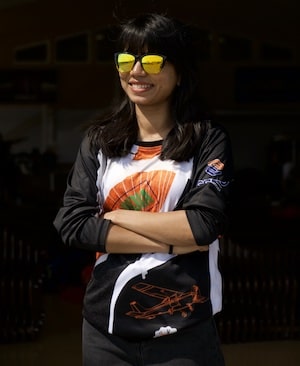
As Gujarat’s first woman skydiver and India’s fourth civilian woman with more than 400 jumps, she had already broken barriers. But it was a conversation with a fellow Indian skydiver that changed her trajectory.
The girl revealed her parents had initially forbidden her from skydiving, believing “Indian girls don’t do such things.” This moment ignited Shweta’s mission: to prove that Indians not only belong in the skies but can thrive there.
Today, Shweta’s Skydive India Campaign (SIC) has empowered over 100 Indians to earn skydiving licenses abroad.
From college students to corporate professionals, her initiative bridges the gap between India’s skydiving dreams and global opportunities. This article explores how Indians can pursue skydiving despite lacking local schools and why Shweta’s campaign is revolutionizing the sport.
Why India Lacks Skydiving Schools?
Skydiving is still a niche in India due to:
- Regulatory Hurdles: Strict aviation laws and limited government support for adventure sports.
- Infrastructure Gaps: No certified skydiving schools that conducts classes in India and training facilities.
- Cultural Perceptions: Skydiving is often seen as “too risky” or “unconventional.”
While tandem jumps are available with SkyHighIndia, they don’t offer licensing programs. For solo skydiving, Indians must look overseas.
How to Learn Skydiving in India?
For Indians, there are two ways to learn solo skydiving. Either join a group travel trip or plan solo to foreign countries.
Option 1: Travel Abroad with the Skydive India Campaign
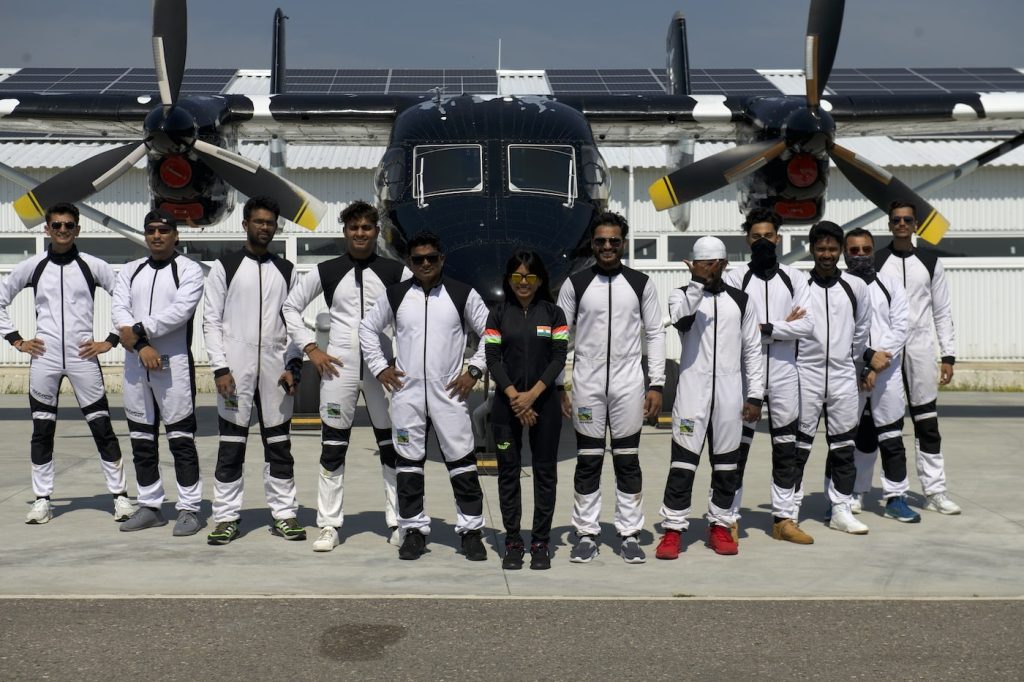
Shweta Parmar’s Skydive India Campaign (SIC) simplifies the process of learning skydiving abroad. Here’s how it works:
Organized Group Trips:
- Destinations: Russia, Spain, Thailand, UAE.
- Packages include training, accommodation, meals, and wind tunnel access.
- Example: A 21-day Russia trip costs ~₹3.8 lakh, covering 25 jumps for a USPA-A license.
Why Choose SIC?
- Safety First: Shweta partners with top-rated dropzones like Krutitcy (Russia) and SkydiveSpain.
- Community Support: Participants train together, creating lifelong bonds.
- Cost Transparency: No hidden fees; budgets cover visas, flights, and repeat jumps.
Recent Trips:
- Russia 2024: 24 participants; 13 completed AFF, 4 earned A licenses.
- Thailand 2023: 6 participants; 4 licensed despite wind tunnel challenges.
Option 2: Self-Planned Training
For independent learners:
- Pros: Flexibility to choose locations/dates.
- Cons: Higher costs, logistical headaches, and no peer support.
Learning Skydiving for Indians: Unique Challenges
Indians face hurdles that skydivers from countries with local schools don’t:
| Challenge | Indian Skydivers | Foreign Skydivers |
|---|---|---|
| Cost | ₹3.5–6 lakh for training + travel | ₹1.5–3 lakh (local schools) |
| Logistics | Visa applications, long flights | Drive to nearby dropzones |
| Training Continuity | Must complete courses in 3–4 weeks | Train weekends over months |
| Community | Limited peer networks in India | Strong local skydiving communities |
Real-Life Example:
A Mumbai-based engineer spent ₹5.2 lakh on a Spain trip. “Without Shweta’s guidance, I’d have wasted money on repeat jumps. She taught us to use wind tunnels strategically,” he says.
Step-by-Step Guide to Skydiving Abroad
India currently lacks the infrastructure and regulatory framework for certified skydiving schools. While tandem jumps are available at a few locations, they are limited to one-time experiences and do not offer training for solo skydiving or licensing.
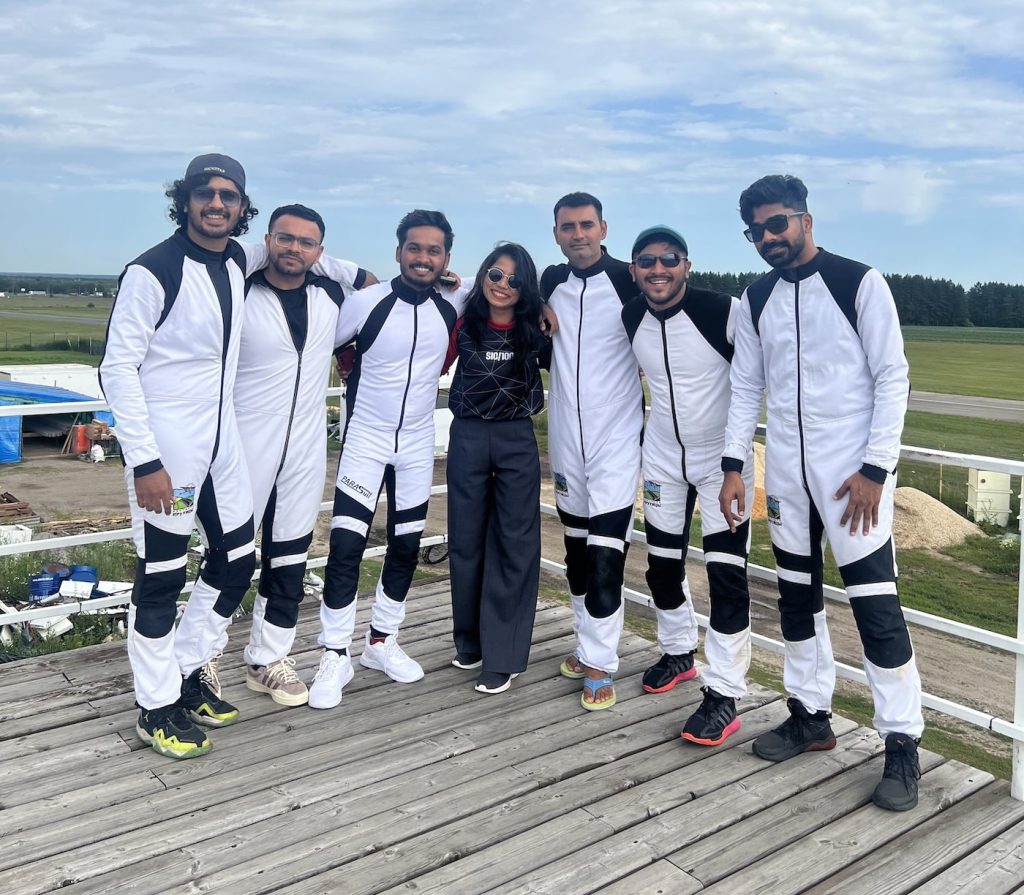
This gap has made it necessary for aspiring skydivers to look beyond Indian borders.
1. Choose Your Destination
- Russia: Best for budget-friendly training (₹3.8 lakh for A License).
- Spain: Ideal for safety-focused learners (₹4.8 lakh).
- Thailand: Scenic but lacks wind tunnels (₹5.1 lakh).
2. Budget Wisely
- AFF Course: ₹1.2–2.3 lakh.
- Flights: ₹25,000–60,000.
- Stay/Food: ₹50,000–80,000 for 3 weeks.
Tip: Allocate 20% extra for weather delays or repeat jumps.
3. Visa Process
- Russia: E-visa in 4 days.
- Spain: Schengen visa (2–3 weeks).
4. Training Timeline
- Days 1–3: Ground school and tandem jumps.
- Days 4–18: AFF levels 1–7 (solo jumps with instructors).
- Days 19–21: Solo jumps to earn your license.
5. Post-License Steps
- Join global skydiving networks like USPA.
- Participate in boogies (skydiving festivals) in Dubai or Thailand.
Nearby Countries for Skydiving Training
Several countries near India offer world-class skydiving training programs. Here are some popular options:
- Russia:
- Why Choose Russia? Affordable training, low repeat jump costs, and wind tunnel facilities.
- Cost: Approximately ₹375,901 for a USPA A License (including all expenses).
- Challenges: Cold weather and language barriers, but the training quality is unmatched.
- Spain:
- Why Choose Spain? Professional instructors, strong safety culture, and scenic dropzones.
- Cost: Approximately ₹487,168 for a USPA A License (including all expenses).
- Challenges: Slightly higher costs, but worth the investment for quality training.
- Thailand:
- Why Choose Thailand? Affordable training and beautiful dropzones.
- Cost: Approximately ₹516,923 for a USPA A License (including all expenses).
- Challenges: No on-site wind tunnel; you may need to travel to Malaysia for additional training.
- Dubai/Abu Dhabi:
- Why Choose UAE? State-of-the-art facilities and year-round good weather.
- Cost: Approximately ₹601,329 (Dubai) or ₹590,008 (Abu Dhabi) for a USPA A License.
- Challenges: Higher costs for training and living expenses.
Key Factors to Consider When Selecting Skydiving School
With determination, proper planning, and the right support, you can learn to skydive in nearby countries and bring your passion back home.
But be very selective when it comes to skydiving school.
- Safety:
- Russia and Spain are known for their strong safety culture and experienced instructors.
- Thailand and Dubai are also safe, but they are more expensive compared to Russia or Spain.
- Cost of AFF Course:
- Russia: ₹120,000 (Krutitcy)
- Spain: ₹167,061 (SkydiveSpain)
- Thailand: ₹220,514 (DropzoneThailand)
- Dubai: ₹236,537 (SkydiveDubai)
- Repeat Jump Costs:
- Russia: ₹17,500 (Level 1-3), ₹18,100 (Level 4-7)
- Spain: ₹23,651 (Level 1-3), ₹23,651 (Level 4-7)
- Thailand: ₹117,700 (Level 1-3), ₹38,000 (Level 4-7)
- Dubai: ₹130,047 (Level 1-3), ₹21,813 (Level 4-7)
- Wind Tunnel Availability:
- Russia: 30 minutes included in the package. Wind tunnel is within walking distance of the dropzone.
- Spain: No wind tunnel included, but facilities are available in the next city (500 km away).
- Thailand: No wind tunnel on-site; you’d need to travel to Malaysia.
- Dubai: Wind tunnel is available on-site but is very expensive.
- Additional Costs (Flights, Stay, Food, Visa):
- Russia:
- Flights: ₹60,000
- Stay: ₹26,400 (22 days)
- Food: ₹26,400 (22 days)
- Visa: ₹15,000
- Spain:
- Flights: ₹60,000
- Stay: ₹53,218 (22 days)
- Food: ₹53,218 (22 days)
- Visa: ₹19,052
- Thailand:
- Flights: ₹30,000
- Stay: ₹39,567 (22 days)
- Food: ₹22,600 (22 days)
- Visa: ₹5,136
- Dubai:
- Flights: ₹25,000
- Stay: ₹77,000 (22 days)
- Food: ₹33,000 (22 days)
- Visa: ₹7,800
- Russia:
Cost Comparison Table
| Factor | Russia | Spain | Thailand | Dubai |
|---|---|---|---|---|
| AFF Cost | ₹120,000 | ₹167,061 | ₹220,514 | ₹236,537 |
| A License Cost | ₹375,901 | ₹487,168 | ₹516,923 | ₹601,329 |
| Repeat Jump Costs | ₹17,500 (L1-3) | ₹23,651 (L1-3) | ₹117,700 (L1-3) | ₹130,047 (L1-3) |
| ₹18,100 (L4-7) | ₹23,651 (L4-7) | ₹38,000 (L4-7) | ₹21,813 (L4-7) | |
| Wind Tunnel | 30 mins included | Not included | Not available | On-site (expensive) |
| Flights | ₹60,000 | ₹60,000 | ₹30,000 | ₹25,000 |
| Stay (22 days) | ₹26,400 | ₹53,218 | ₹39,567 | ₹77,000 |
| Food (22 days) | ₹26,400 | ₹53,218 | ₹22,600 | ₹33,000 |
| Visa | ₹15,000 | ₹19,052 | ₹5,136 | ₹7,800 |
| Safety | High | High | Moderate | High |
| Community Support | Strong | Strong | Moderate | Moderate |
My Recommendation
Based on the cost breakdown and overall value, I recommend Russia or Spain over Thailand and Dubai. Here’s why:
- Russia:
- Lowest repeat jump costs.
- Wind tunnel included in the package.
- Strong safety culture and community support.
- Affordable stay and food costs.
- Spain:
- Excellent safety standards and professional instructors.
- Well-established skydiving community.
- Slightly higher costs but worth the investment for the quality of training.
While Thailand is the cheapest option, the lack of wind tunnel facilities and higher repeat jump costs can make it less economical in the long run. Dubai is also a good option but tends to be more expensive overall.
Success Stories from the Skydive India Campaign
Instead of us writing success stories, why don’t you read about them yourself? Connect with our students on Instagram and get their reviews yourself.
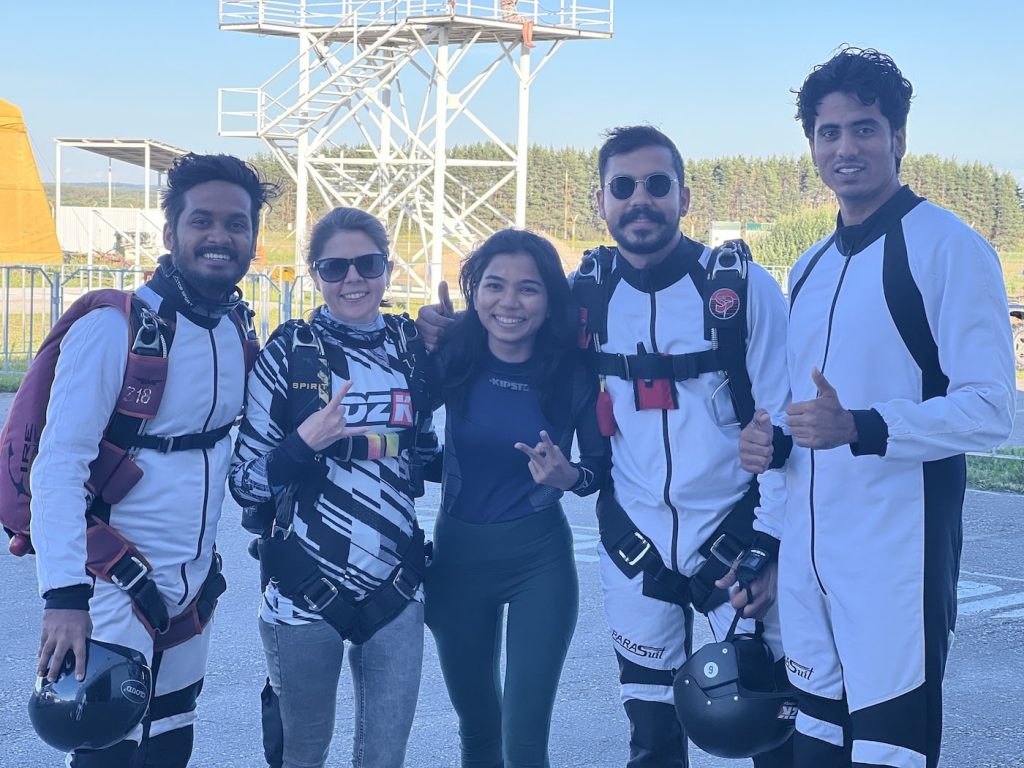
Afsar Inamdar From Pune
Afsar Inamdar, a licensed skydiver hailing from Pune, India, is fueled by his passion for flying. With dedication and sheer determination, he’s achieved his dream of becoming a licensed skydiver. When he’s not diving from the skies, Afsar can be found excelling in his role at the Amazon development center. Instagram: @skydiver_afsar
Madhav Maheshwari From Surat
Earned USPA-A in one trip from Krutitcy during the SkydiveIndiaCampaign’s thrilling trip to Russia in July 2023. He will be soon finishing the 200 jumps. Instagram: @madhavmaheshwarii
Vinod Jain from Mumbai
Finished AFF from DropzoneThailand during the SkydiveIndiaCampaign’s thrilling trip to Thailand in Dec 2023. Finished A license on his next trip to Russia in June 2024. He is been a passionately active skydiver ever since. Instagram: @skydiver_vj
Prince Kumar from Punjab
His journey has been the most amazing one. He joined the Russia 2024 trip. In Krutitcy, even after wind tunnel and multiple repeat jumps, he couldn’t finish his AFF. So, He went to another dropzone in Russia. He could finish his AFF but couldn’t get his USPA-A license. So, he decided to visit Thailand and finally get his USPA-A license. Instagram: @monkonadventure
and 50 others whom you can find here
Future of Skydiving in India
Shweta’s long-term goals include:
- Advocating for India’s first certified dropzone.
- Training Indian instructors to reduce dependency on foreign schools.
- Hosting skydiving festivals to boost awareness.
“Imagine jumping over the Himalayas or Goa’s beaches,” Shweta says. “It’s possible if we build the ecosystem.”
Conclusion: The Sky is Not the Limit
The absence of skydiving schools in India is a hurdle, not a dead end. With pioneers like Shweta Parmar, Indians can now access world-class training abroad and bring their skills home. Whether you’re a student saving pocket money or a professional seeking adventure, the Skydive India Campaign proves that passion transcends borders.
As Shweta often says: “Fear is just a cloud—jump through it, and you’ll find the sky is yours.”
Ready to leap?
- Follow @SkydiverShweta on Instagram.
- Visit the Skydive India Campaign for upcoming trips.
Blue skies and happy freefall! ✨
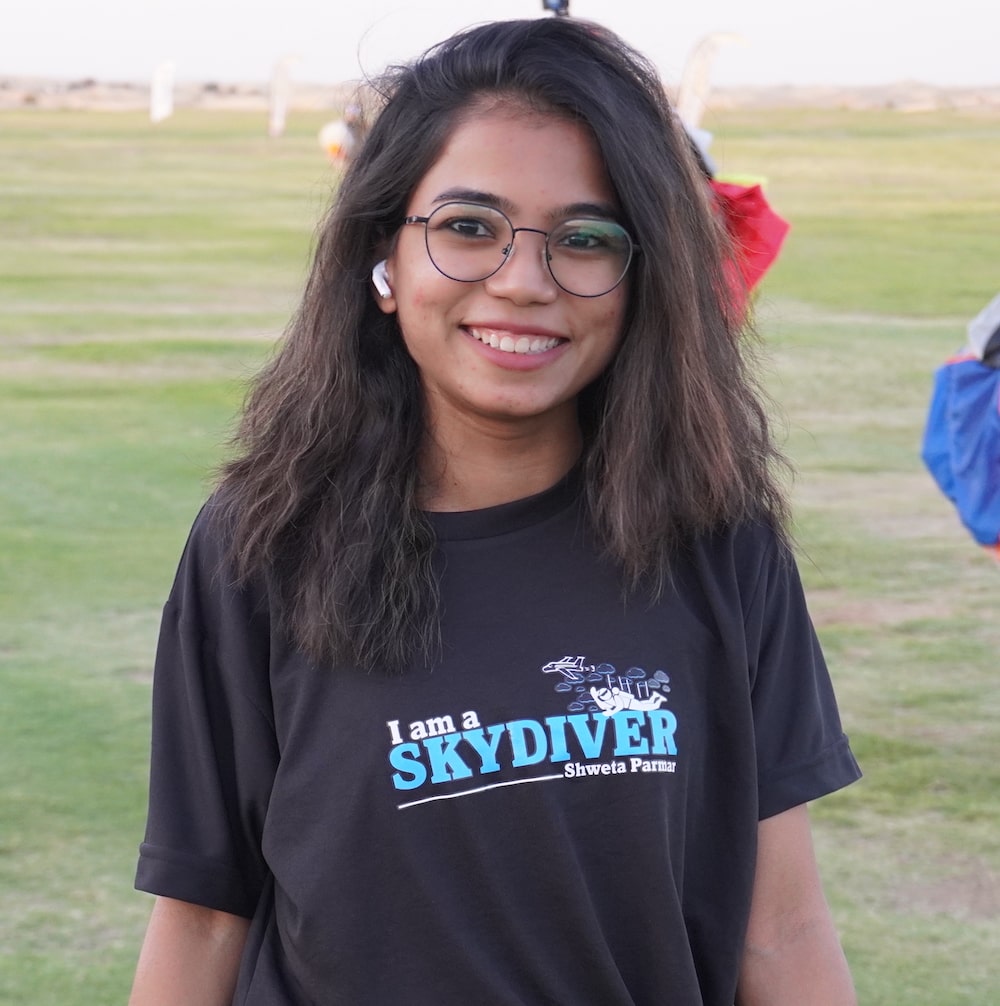
Shweta Parmar is a skydiver, skier, and co-founder of Techmero. She is the fourth civilian woman skydiver from India and the First from Gujarat. Shweta lives in Vadodara, Gujarat, India. Flying with her own wings is her dream.
Do we have any skydiving schools in India?